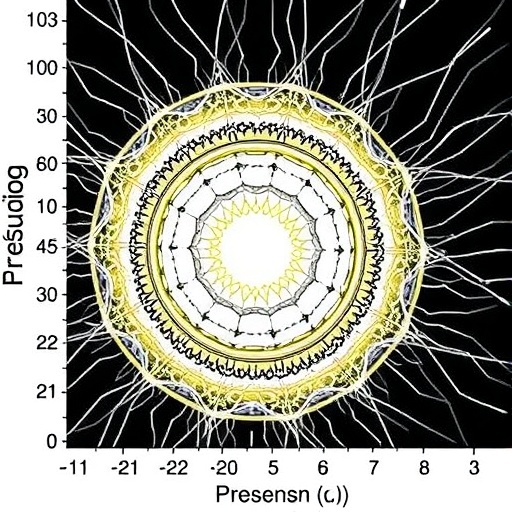Recent research efforts have shed new light on the ionic conduction properties of specific fluoride ion conductors under varying pressure conditions. A study conducted by M.M. Ahmad probes into the nuances of how pressure affects the ionic conduction and relaxation characteristics of a novel compound, Pb0.7Sn0.3F2. This investigation is poised to significantly contribute to the understanding of ionic conductors, which are crucial in various applications ranging from batteries to fuel cells and beyond.
The fundamental aspect of this research lies in the unique structure of Pb0.7Sn0.3F2, a compound composed of lead, tin, and fluorine. The specific ionic conduction properties of this material are attributed to its crystal lattice structure, which facilitates the movement of ions. Ionic conduction is essential for many electronic materials, as it allows for the rapid movement of charge carriers, thus influencing overall performance. Ahmad’s exploration into the effects of pressure unveils potential new mechanisms that could enhance our understanding of these properties.
Interestingly, the experiment was designed to observe ionic conduction behavior under high-pressure conditions. The researchers used advanced techniques to manipulate the environment surrounding the sample, applying pressure while simultaneously measuring the conduction properties. Through this approach, Ahmad succeeded in discerning how the movements of ions are influenced not only by temperature but also by the exerted pressure. This new perspective on ionic mobility can lead to enhanced designs for future materials used in electronic applications.
Apart from measuring conduction characteristics, the study also delves into the relaxation properties of ions within the Pb0.7Sn0.3F2. Relaxation properties refer to how quickly and effectively the system returns to equilibrium after being disturbed. Under pressure, the relaxation times changed significantly, indicating the profound impact pressure has on ionic movement and behavior. Understanding these properties is invaluable; it lends insights into how similar materials might perform under extreme conditions often encountered in actual applications.
The methodology employed by Ahmad emphasizes advanced experimental techniques, including impedance spectroscopy to assess the electrical properties of the material. This technique allows for a nuanced understanding of the frequency response of the ionic conduction, revealing how ions behave under different frequencies of applied electric fields. The findings suggest that optimizing the conductivity and relaxation dynamics of ionic conductors could help design better solid electrolytes for various energy storage applications.
Notably, the impact of pressure on the ionic conduction of Pb0.7Sn0.3F2 can open avenues for further studies focusing on similar materials. Future research could explore analogous fluoride-based conductors to determine whether the observed phenomena are similarly applicable across various compositions. Such studies can uncover new materials with superior ionic conduction properties, propelling advancements in the energy sector.
Moreover, the implications of this study extend into theoretical realms as well. Understanding how pressure influences ionic movements can inspire new theoretical models of ionic conduction. Such models could incorporate pressure as a variable, adding complexity and depth to existing frameworks. As researchers and scientists develop a broader understanding of ionic conductors, the knowledge gleaned from Ahmad’s research offers potential pathways toward innovative applications.
The environmental conditions under which materials are tested can also greatly influence the results, leading to the conclusion that adjustments in external factors can have substantive implications on the performance of ionic conductors. The research serves as a reminder that the physical world around us can dramatically alter the behavior of materials, a reality that material scientists must always consider.
With the growing interest in sustainable energy solutions, research like Ahmad’s is particularly relevant. The exploration of ionic materials plays a crucial role in the drive to create more efficient and environmentally friendly energy systems. As researchers continue to investigate how various conditions affect material properties, the foundation for greener technologies solidifies. The ultimate goal remains clear: advancing the science of materials to meet energy demands sustainably.
In summary, the research presented in Ahmad’s study paves the way for deeper insights into ionic conduction, revealing how pressure interplays with material properties. As scientists challenge existing paradigms and seek new configurations, the outlook is bright for the development of advanced ionic conductors that could change the landscape of numerous electronic applications. The work not only highlights the importance of pressure in material science but also underscores the need for ongoing research in this field.
In conclusion, Ahmad’s findings beckon future investigations that could illuminate other physical parameters affecting ionic conduction. As the electrification of transportation and renewable energy storage systems takes center stage, understanding the phenomena highlighted in this research will be instrumental in driving innovation. This pivotal research serves as a crucial stepping stone toward the next generation of high-performance ionic materials, ushering in advances that will serve both industry and society at large.
The comprehensive understanding derived from Ahmad’s exploration emphasizes the intricate relationships governing material behavior under pressure. With each new finding, the scientific community takes one step closer to unlocking the full potential of ionic conductors, translating lab discoveries into practical, real-world solutions.
Subject of Research: Effects of pressure on ionic conduction and relaxation properties in ionic conductors.
Article Title: Effect of pressure on the ionic conduction and relaxation properties of Pb0.7Sn0.3F2 fluoride ion conductors.
Article References:
Ahmad, M.M. Effect of pressure on the ionic conduction and relaxation properties of Pb0.7Sn0.3F2 fluoride ion conductors.
Ionics (2025). https://doi.org/10.1007/s11581-025-06651-0
Image Credits: AI Generated
DOI: https://doi.org/10.1007/s11581-025-06651-0
Keywords: Ionic conduction, Pb0.7Sn0.3F2, relaxation properties, pressure effects, fluoride ion conductors.




